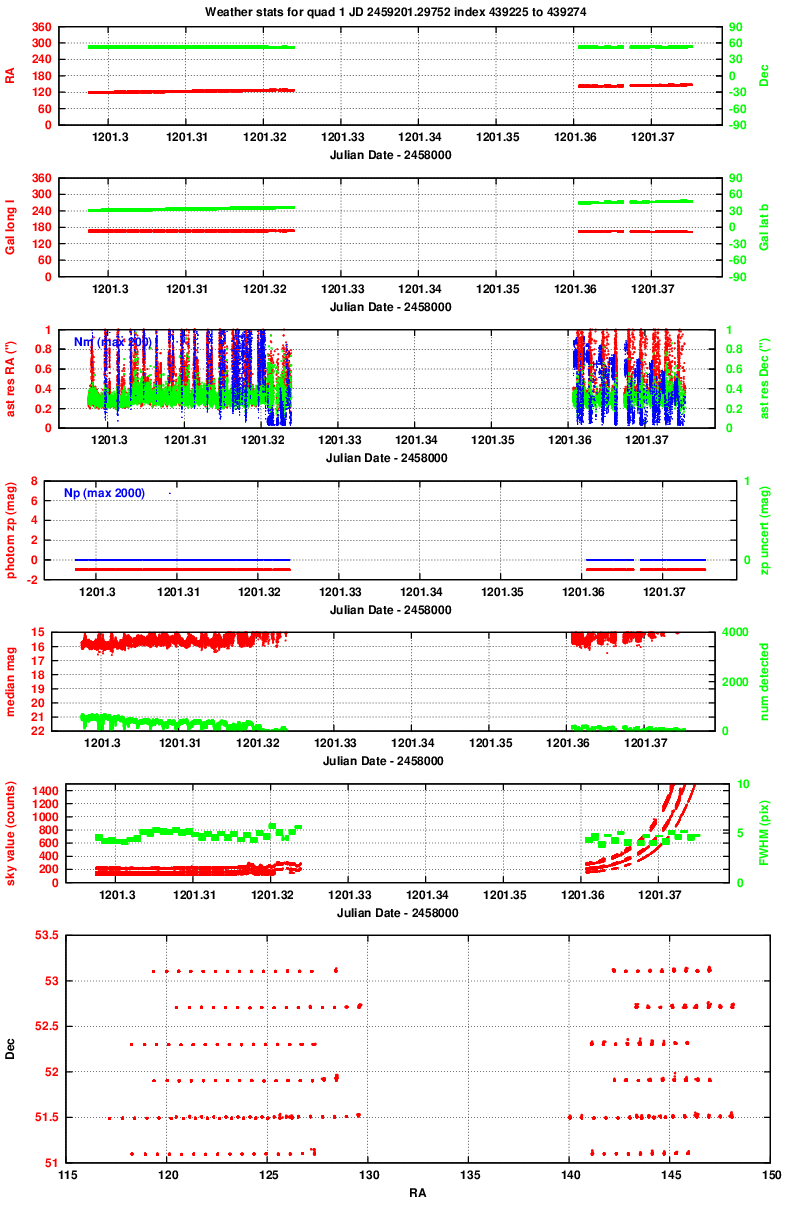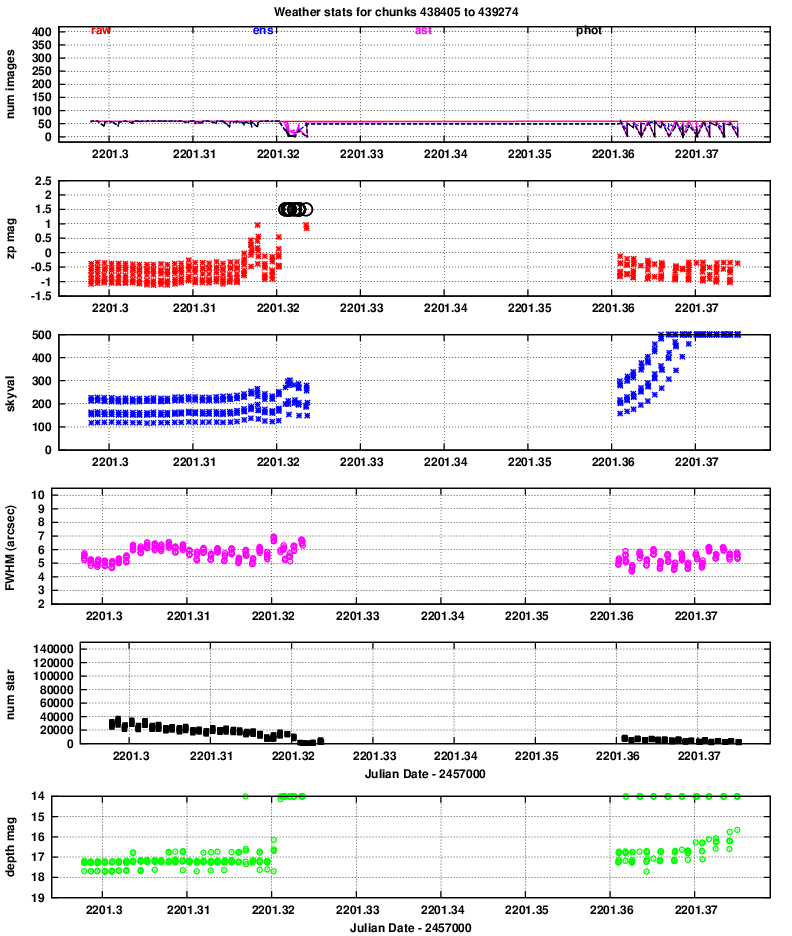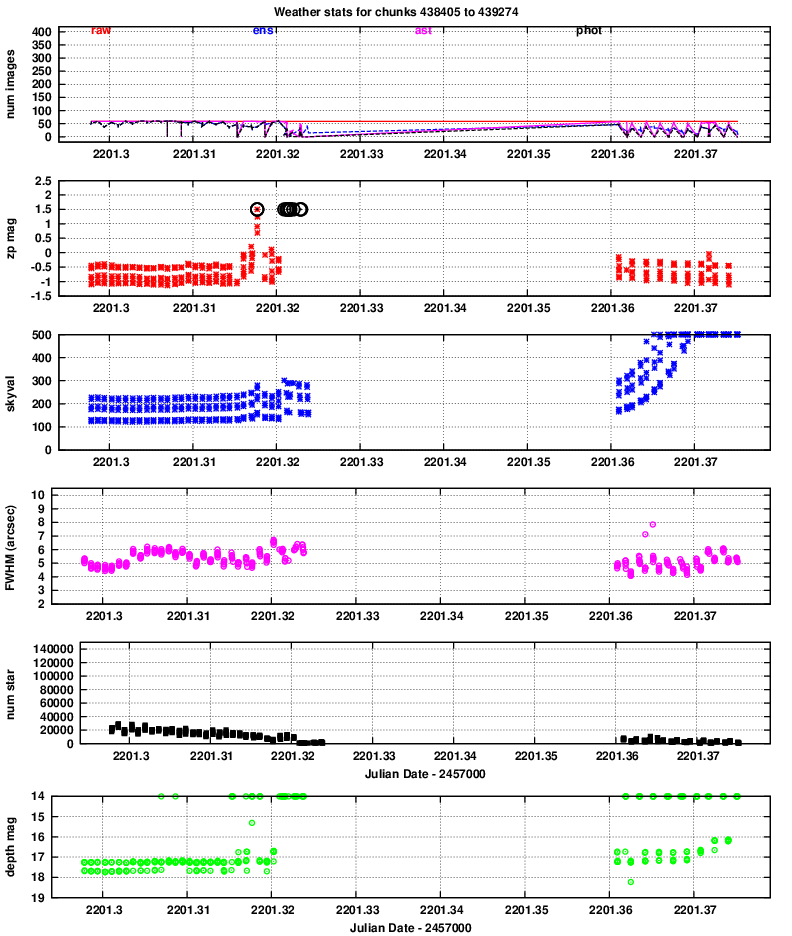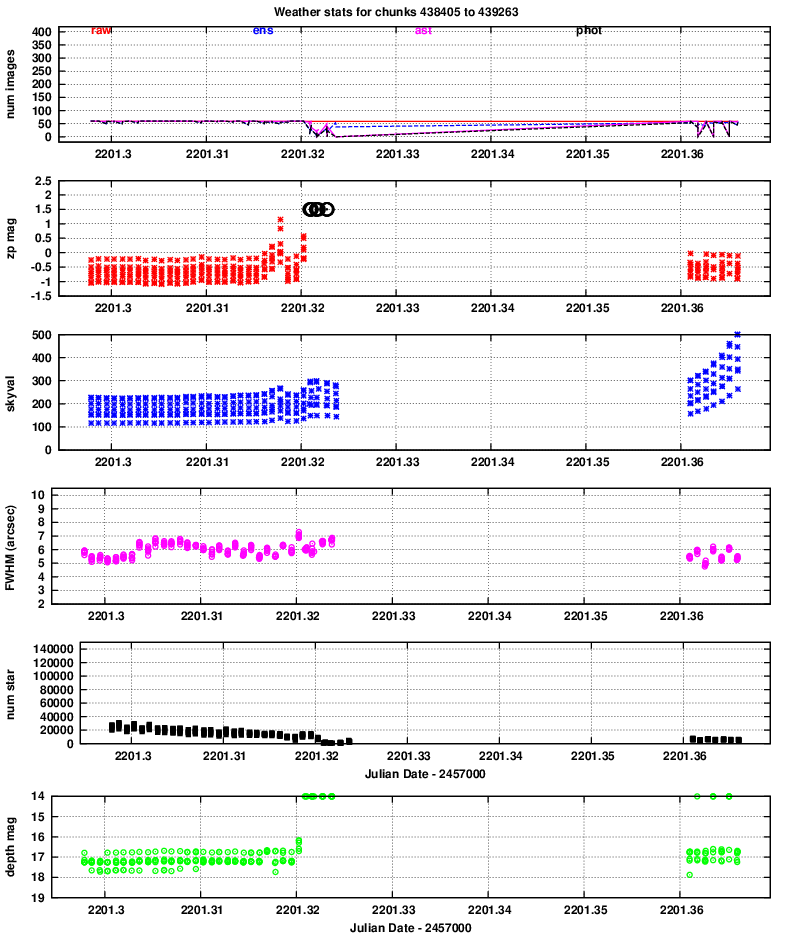
On Dec 17, 2020, the Tomo-e camera carried out a relatively short (approx 1 hour) survey of regions cooperatively with the FAST telescope, looking for fast radio bursts. Only 1/3 of the chips were used to collect data (as far as I can tell). My search revealed no transients with durations of 3-20 seconds.
The dataset "20201217" is based on images acquired during UT 2019 Dec 17, with PROJECT name 'FAST survey' and OBSERVER 'Y. Niino'. The images cover the span of time
2459201.298 ≤ JD ≤ 2459201.375
with a gap in the middle. The span of active collection time is only about 60 minutes, and much of the second half of that time is plagued by clouds. All four quadrants were active, but data from only 1/3 of all the chips was saved, as far as I can tell. This is therefore a small datatset.
The FITS headers of one of these images states, in part:
OBJECT = 'FASTsurvey' / object name EXPTIME = 59.994240 / [s] total exposure time TELAPSE = 60.500020 / [s] elapsed time EXPTIME1= 0.999904 / [s] exposure time per frame TFRAME = 1.000000 / [s] frame interval in seconds DATA-FPS= 1.000000 / [Hz] frame per second DATA-TYP= 'OBJECT' / data type (OBJECT,FLAT,DARK) OBS-MOD = 'Imaging' / observation mode FILTER = 'BLANK' / filter name PROJECT = 'FAST survey' / project name OBSERVER= 'Y. Niino' / observer name PIPELINE= 'wcs,neo,stack,raw' / reduction pipeline templete
The images were reduced and cleaned by others; I started with clean versions of the images. Each set of 60 images was packed into a single FITS file, covering a span of (60 * 1.0 sec) = 60 seconds. These "chunk" files were transferred to shinohara by me, and placed in
/gwkiso/tomoesn/richmond/work/work_20201217
with names like
rTMQ2202012170043926213.fits
These names can be decoded as follows:
r stands for "reduced" ??
TMQ2 means "Tomoe data, part of quadrant 2"
20201217 means year 2020, month 12, day 17
00439262 means chunk index 00439262 (increased with time)
13 means chip 13
.fits means a FITS file
I'll refer to each of these "composite" files as a "chunk".
There are typically 43 chunks for each chip, and a total of 1358 chunks in the entire dataset. Each chunk file was 541 MByte, so the total volume of the chunk files was about 734 GByte = 0.7 TByte.
I ran a slightly modified version of the Tomoe pipeline on the images; it was not the same as that used to analyze the 2016 images discussed in the transient paper for two reasons:
The main stages in the pipeline were:
The output of the pipeline includes a copy of each FITS image, plus a set of ASCII text files which include both the raw, uncalibrated star lists, and the calibrated versions of those lists, as well as the ensemble output. Let's compare the sizes of the input and output for quadrant 1:
Note that the input images contain 32 bits per pixel, while the output images created by the pipeline have only 16 bits per pixel. Thus, the output images are only half the size of the input. Aside from the FITS images, all the other text output of the pipeline is very small.
The figure below shows, in the bottom panel, the (RA, Dec) location of these observations. The fields are relatively far from the plane of the Milky Way, at galactic latitude 30-45 degrees (as shown in the second panel).

After running the pipeline to reduce the data, clean the images, find and measure stars, calibrate them astrometrically and photometrically, I used a script to look at properties of the data over the course of the night. You can read more about the "weather" in another note.
Below are links to the graphs produced for each of the 4 quadrants.
Quadrant 1:

Quadrant 2:

Quadrant 3:

Quadrant 4:

zp = (instrumental_mag) - (calibrated_mag)
Large positive values indicate extinction due to the atmosphere or clouds.
Near the end of the first set of images, the zero-point rose -- that's due to clouds. I guess that clouds stopped the observations for a while, explaining the gap.
There is a drop in the number of stars detected with time, probably due to clouds, then the rising brightness due to dawn.
The images typically show stars down to mag V = 17 and a bit fainter, which is relatively normal.
After all the data had been calibrated, I ran the "transient_a.pl" script, which applies the rules described in the Tomo-e transient search paper to look for sources with only a brief existence. The code also computes a "control time" for the dataset.
The software found 343, 333, 242, 285 candidates in quadrants 1, 2, 3, and 4, respectively. This is roughly 10 times as many as were found in the Nov-Dec 2019 dataset. I created a web page showing the properties of these candidates in each quadrant:
The entry for each candidate includes some information about the chunk in which it appears, its position in (x,y) pixel coordinates and (RA, Dec) coordinates, and its magnitude. The "variability score" describes the ratio of the standard deviation of its magnitudes away from the mean to the standard deviation from the mean of stars of similar brightness; so, a high score means the object is varying from frame to frame more than most objects of similar brightness.
The entries also contain columns listing the magnitudes of any objects at this position (to within 5 arcsec) in the USNO B1.0 (avergage of R-band magnitudes) and in the 2MASS catalog (K-band magnitude). A value of "99.0" indicates that no source appears in the catalog as this position. You can see that the overwhelming majority of candidates do correspond to objects which were detected in one or both of these catalogs -- meaning that they are not true transients.
After these columns of text, the documents contain thumbnails of the images around the candidate. The thumbnails are oriented with North up, East left, and are 110 pixels (= 130 arcsec) on a side.
I found no candidates which looked like real transients in this dataset; feel free to examine them yourself.
The table below shows the control times for each quadrant in this dataset:
quadrant control time (square degrees * sec)
V=13 V=14 V=15 V=16
--------------------------------------------------------
1 3896 3762 3123 224
2 3060 2991 2753 581
3 3445 3378 3036 134
4 3450 3285 2582 27
total 13851 13416 11764 966
--------------------------------------------------------
The total control time is of order 1,000 square degrees times seconds, down to a limit of V=16 in a 1-second exposure.
These control times are much smaller than the control times listed in the transient paper.